Equine tetanus
Case report
DOI:
https://doi.org/10.31533/pubvet.v18n03e1563Keywords:
Antitetanus serum, tetanospasmin, tetanolysin, toxi-infectionAbstract
Tetanus is caused by toxins (tetanospasmin, tetanolysin and a non-spasmogenic toxin) synthesized by Clostridium tetani, a gram-positive, sporulating and obligate anaerobic bacterium. The equine species has high exposure and sensitivity to the pathogen. Therefore, prophylactic measures such as vaccination, antisepsis of wounds with hydrogen peroxide, and anti-tetanus serum in surgeries carried out in the field are essential for prevention. The clinical signs presented are the main diagnostic tool, as most of the time the signs are pathognomonic, including sawhorse stance, rigid gait, flag tail, protrusion of the 3rd eyelid, sensitivity to sound and light stimuli, dyspnea and dysphagia. Toxi-infection occurs from pre-existing wounds or from gastrointestinal injuries. The objective of this study is to report a case of tetanus in a 10-year-old grade mare, addressing diagnostic and therapeutic characteristics. Clinical treatment proved to be effective, with satisfactory results after intrathecal and intravenous application of anti-tetanus serum, combined with antibiotic therapy and medications that promote muscle relaxation. The animal was discharged after 22 days of clinically stable hospitalization.
References
Avante, M. G., Okada, C. T. C., Trecenti, A. S., & Romão, F. T. N. M. A. (2016). Tétano em um equino: Relato de caso. Revista Cientifica de Medicina Veterinária, 26, 1–9. https://doi.org/10.51161/convesp2023/18025.
Dalmaso, T. J., Dambroz, M. H., Beck, C., & Pereira, R. C. D. F. (2015). Tratamento responsivo de um equino com tétano- relato de caso. XXIII Seminário de Iniciação Científica - Curso de Medicina Veterinária.
Filippo, P. A., Graça, F. A. S., Costa, A. P. D., Coutinho, I. S., & Viana, I. S. (2016). Clinical and epidemiological findings and response to treatment of 25 cases of tetanus in horses occurred in Norte Fluminense, Rio de Janeiro, Brazil. Revista Brasileira de Medicina Veterinária, 38(1), 33–38.
Kabura, L., Ilibagiza, D., Menten, J., & Van den Ende, J. (2006). Intrathecal vs. intramuscular administration of human antitetanus immunoglobulin or equine tetanus antitoxin in the treatment of tetanus: a meta‐analysis. Tropical Medicine & International Health, 11(7), 1075–1081. https://doi.org/10.1111/j.1365-3156.2006.01659.x.
Kay, G., & Knottenbelt, D. C. (2007). Tetanus in equids: a report of 56 cases. Equine Veterinary Education, 19(2), 107–112. http://dx.doi.org/10.2746/095777307x181320
Leira, M. H. L., Oliveira, M. P., Reghim, L. S., Peters, A. P., Almeida, L. P. S., Braz, M. S., & Franzo, S. V. (2017). Tétano em um equino: Relato de caso. PUBVET, 11(1), 50–54. https://doi.org/10.7213/academica.15.s01.2017.193.
Lima, J. T. B., Patrício, L. A. M. M., Amorim, F. A. F., Santos, S. G., & Baptista Filho, L. C. F. B. (2013). Tétano em equino: Relato de caso. In U. F. de Recife (Ed.), Jornada de Ensino, Pesquisa e Extensão (Vol. 8).
Mayhew, J. (2009). Tetany, tremor and postural and movement disorders. 1th International Congress of World Equine Veterinary Association.
Megid, J., Ribeiro, M. G., & Paes, A. C. (2016). Doenças infecciosas em animais de produção e de companhia. Guanabara, Koogan.
Pereira, A. L. A., Gonçalves, T. F., Dantas, J. B. G., Oliveira, M. P. M., Gomes, J. B., Tolentino, M. L. D. L., Pereira, E. A., Martins, K. F., Sousa, D. C., Silva Filho, M. L. (2019). Tétano em equino: Relato de caso. PUBVET, 13(6), 1–6. https://doi.org/10.31533/pubvet.v13n6a357.1-6.
Popoff, M. R. (2020). Tetanus in animals. Journal of Veterinary Diagnostic Investigation, 32(2), 184–191.
Reed, S. M., Bayly, W. M., & Sellon, D. C. (2009). Equine internal medicine. Elsevier Health Sciences. http://dx.doi.org/10.1016/b978-0-443-06839-3.00244-7
Reed, S. M., Bayly, W. M., & Sellon, D. C. (2022). Medicina interna equina. Guanabara Koogan S.A.
Reddy, P., & Bleck, T. (2009). Clostridium tetani (Tetanus). In Mandell, G. L, Benett, J. E., & Dolin. R. (Eds.), Principles and practice of infectious diseases. Elselvier Saunders.
Reichmann, P., Lisboa, J. A. N., & Araujo, R. G. (2008). Tetanus in equids: A review of 76 cases. Journal of Equine Veterinary Science, 28(9), 518–523. http://dx.doi.org/10.1016/j.jevs.2008.07.019
Ribeiro, M. G., Nardi Júnior, G., Megid, J., Franco, M. M. J., Guerra, S. T., Portilho, F. V. R., Rodrigues, S. A., & Paes, A. C. (2018). Tetanus in horses: An overview of 70 cases. Pesquisa Veterinária Brasileira, 38, 285–293. http://dx.doi.org/10.1590/1678-5150-pvb-5441
Silva, A. A., Stelmann, U. J. P., Papa, J. P., Fonseca, E. F., Ignácio, F. S., Ferreira, J. C., & Ribeiro Filho, J. D. (2010). Uso de antitoxina tetânica por via intratecal e endovenosa no tratamento de tétano acidental em equino: Relato de caso. Revista Científica Eletrônica de Medicina Veterinária–ISSN: 1679-7353, 14, 1–11. http://dx.doi.org/10.14393/vtv22n1a2016.28084
Smith, B. P. (2014). Large animal internal medicine-E-Book. Elsevier Health Sciences.
Vieira, C. A. M. (2017). Tétano em um equino: Relato de caso. Revista Acadêmica Ciência Animal, 15, 387–388. https://doi.org/10.7213/academica.15.s01.2017.193.
Downloads
Published
Issue
Section
License
Copyright (c) 2024 João Vitor Fraianella Teixeira de Godoy, Camila Alves Sobral, Tainá Rodrigues de Oliveira Zamian, Fernanda Meireles dos Reis, Gabriela Barbosa de Almeida, Paula Cristina Guimarães, Paulo Roberto Griska, Danielle Baccarelli da Silva , Michele Andrade de Barros

This work is licensed under a Creative Commons Attribution 4.0 International License.
Você tem o direito de:
Compartilhar — copiar e redistribuir o material em qualquer suporte ou formato
Adaptar — remixar, transformar, e criar a partir do material para qualquer fim, mesmo que comercial.
O licenciante não pode revogar estes direitos desde que você respeite os termos da licença. De acordo com os termos seguintes:
Atribuição
— Você deve dar o crédito apropriado, prover um link para a licença e indicar se mudanças foram feitas. Você deve fazê-lo em qualquer circunstância razoável, mas de nenhuma maneira que sugira que o licenciante apoia você ou o seu uso. Sem restrições adicionais
— Você não pode aplicar termos jurídicos ou medidas de caráter tecnológico que restrinjam legalmente outros de fazerem algo que a licença permita.





